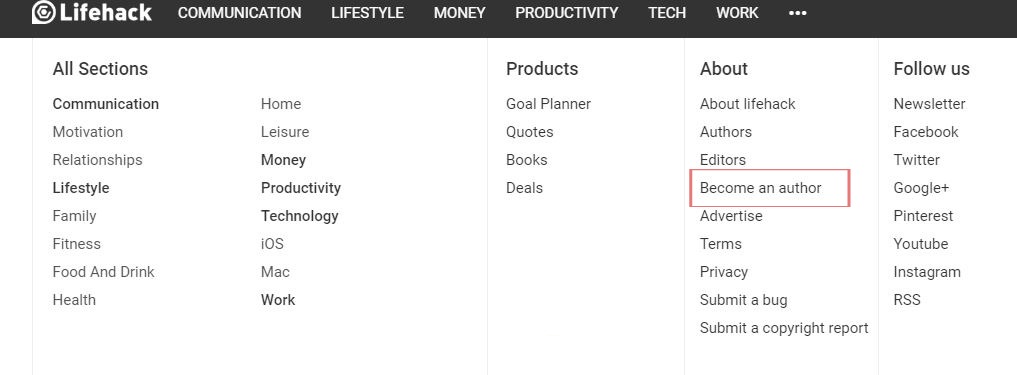We have two words for you: quality and rights.
The main reasons you want to create clear contributor guidelines come down to those two things:
- Quality. Clear contributor guidelines significantly increase the quality of the submissions you receive and the content you publish. That’s not to say you won’t receive any more sloppy pitches or posts, but it does help eliminate some of the amateurs. It also helps the professionals nail your audience, voice and style.
- Rights. Guidelines make it clear who owns what and for how long. For example, Fast Company’s contributor guidelines state, “Fast Company requests that contributed articles remain exclusive to our site for three to five business days, after which time they may be reprinted in part or full on other sites, with a link back to the original article on Fast Company.” So it’s clear what the expectations are around reposting and excerpting.
How to create great contributor guidelines
1. List what’s important

Audience. You cannot give too much detail here. If you don’t lay out precisely whom you’re targeting, don’t be surprised when writers don’t nail it. Take the time to create marketing personas.
Original content requirements. Most sites only want original content, and if this is true for you, say so. Others allow authors to republish their posts 3-6 weeks after they go live, as long as the headline is changed and/or they use a rel=“canonical” tag.
What’s the point? Tell them what you want your blog to achieve. Is it there to increase traffic, get more social shares or generate leads? Do you encourage controversy? Are you trying to rank for certain keywords?
2. Your guidelines should also include
You should also provide the following information to potential contributors:
- Voice, tone and style
- Word count and formatting requirements
- Topics your blog covers and examples of popular posts
- Quality expectations
- Images and media expectations
- Links and author bio
- Whom to contact
3. Lay your guidelines out like a blog post
Break things up with subheadings and plenty of white space, so readers aren’t overwhelmed when wading through the details.
4. Make them visible
It might seem obvious, but great contributor guidelines are visible on the site. Some sites seem to bury their guidelines under their contact information, or don’t list contributor guidelines on their menu or in their footer.
If you’re going to create contributor guidelines, make sure people can find them quickly. Put them in your menu, or in your footer so that people who look for them can find them and read them, like this example from Lifehack.
Also, optimize the page for search by including phrases like “contributor guidelines,” “write for us” or “editorial guidelines.”
5. Include rough time frames
Set expectations for authors by including rough time frames in your guidelines. Erin at Pick the Brain says it may take up to two weeks to hear back, but she’ll definitely send an email. Other sites say things like, “If you haven’t heard back from us in three weeks, it means we’re not interested.”
6. Provide your editing policy

7. Define your quality requirements
Many sites say that they expect pieces to have correct spelling, grammar and punctuation — this might seem obvious, but it’s useful to remind potential writers that this is expected. It sets a bar for quality. Time Management Ninja makes this clear by saying, “The more I have to edit your post, the less likely it will be chosen for publication.”
8. Spell out the following policies

Bylines and bios. This is where publications usually give links to writers — in their bio. And while it may seem obvious what sort of credit and byline your contributors will receive, it never hurts to spell it out. If you only publish one link for each author, state that. If you prefer to publish links to social media rather than websites, make that clear too.
Pitching. Over at StartupBros, they ask writers to submit an idea and make it clear they won’t read a full post, whereas Addicted2Success wants a final draft of the full article. You can request writers submit articles on a regular basis, and that pitches are sent the way you want so it’s quicker and easier for you to assess them. Again, let contributors know precisely what you want here.
How to submit. Do you want a Google doc? Word attachment?
Sharing. Encourage contributors to share and promote the articles they write for your blog.
Community participation. Do you expect authors to respond to post comments for the first week or two after the piece is posted? If so, you’ll need to state that, along with your expectations that the responses will be professional. You’ll also need to email the author when their piece goes live, so they know to keep an eye out for comments.
Bonus tip: Reduce inbox clutter
If you want to reduce the amount of email you receive (and who doesn’t these days), consider creating a separate email address purely for blog submissions. This saves you wading through your inbox searching for contributor posts.
Great guidelines = Great content
Taking the time to establish solid contributor guidelines for your blog pays off by allowing you to fine-tune the blog’s mission and audience. It also enables your contributors to submit pieces that are more consistent in tone, voice and topic.
You’ll receive higher-quality submissions, and everyone will be clear on the policies and process. More importantly, there should be little doubt about who owns the rights to any posts, either now or in the future.
If you need any help at all with crafting high-quality contributor guidelines, ClearVoice has your back. We have over a decade of experience helping brands achieve success. Talk to a specialist today.






